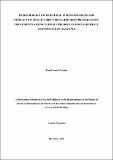Epidemiology of intestinal schistosomiasis and efficacy of single versus repeated dose praziquantel treatments among schoolchildren in Rorya district, Northwestern Tanzania
Abstract
In Schistosoma mansoni endemic areas, administering repeated treatments may increase praziquantel cure rate (CR) and egg reduction rate (ERR), thereby improving morbidity reduction and hastening achievement of transmission control in these areas. This was a longitudinal study which investigated the efficacy of single versus repeated praziquantel treatments of S.mansoni infections and its impact on undernutrition and anaemia. Stool samples were collected from 513 schoolchildren and examined for S.mansoni infections using the Kato-Katz method. Questionnaires were used to collect socio- demographic data, risk factors, knowledge, attitude and practices on schistosomiasis. Nutritional status was determined by anthropometry. Blood samples were collected and examined for malaria parasites and haemoglobin levels using the Giemsa stain and HaemoCue methods, respectively. The prevalence of S.mansoni, malaria, stunting, wasting and anaemia were 84.01%, 9.16%, 38.21%, 14.42% and 29.43%, respectively. The geometric mean (GM) egg per gram of stool for S.mansoni was 167.13 (95%CI: 147.19–189.79) eggs per gram of stool. Village of residence, parent’s level of education, toilet use and treatment history were predictors of S.mansoni infection. A total of 431 S.mansoni infected schoolchildren were randomized to either receive a single or repeated 40mg/kg dose of praziquantel. At 8 weeks post baseline treatment, CR was higher among those on repeated dose (93.10%) than those on a single dose (68.68%, p0.05), with significant increase in mean haemoglobin (p0.05). Majority (93%) of participants mentioned using lake water for domestic chores. Although toilet ownership was high (84.61%), regular toilet use was low (55.31%). To be of sustained benefit, repeated dose praziquantel treatments should be coupled with other control measures that aim at reducing the rate of re-infection and environmental contamination.

